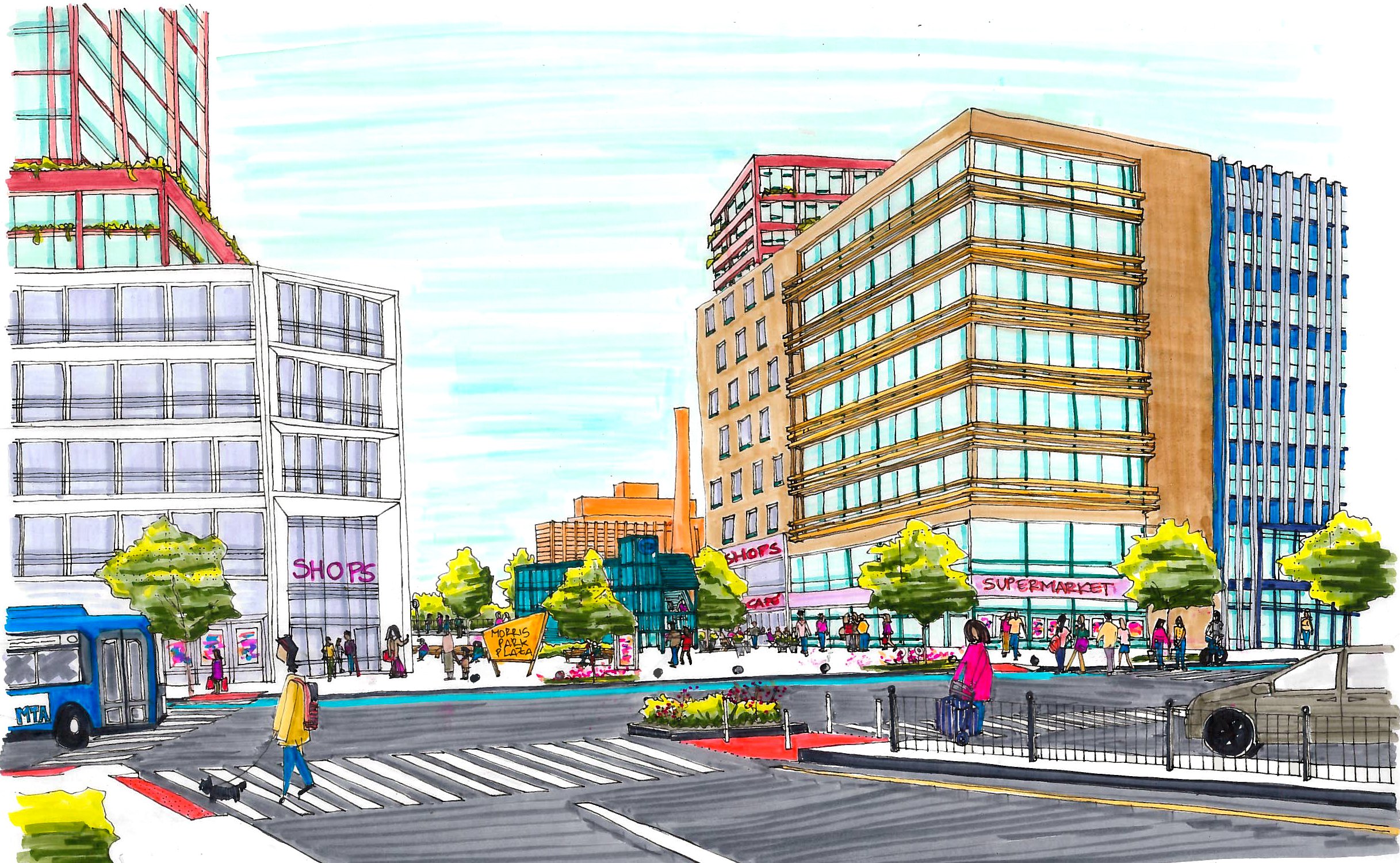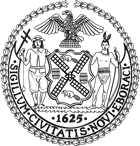Key Investments
Economic Growth
The city’s goal of achieving both equitable and economic growth drives capital investment decisions. Capital investments seed growth in large and small businesses and create the infrastructure that makes our business districts successful regional and global centers. This includes investing directly in NYC’s small businesses and training programs that connect New Yorkers to new opportunities. It also includes investing in the infrastructure that underpins our commercial districts and the transportation infrastructure that allows New Yorkers and regional workers to access a diversity of jobs. These investments, especially those helping support small businesses and fledgling industries, are essential to the economic growth and prosperity of the city.
Planning for changes in job trends
The city analyzes employment trends to guide capital investments, helping to create jobs and support growth in areas expected to expand. These efforts also reinforce nearby affordable housing and mixed-use developments that encourage small business success. Emerging central business districts also need sufficient transit capacity.
As of late 2024, NYC was home to a record level of 4.6 million jobs, exceeding the city’s pre-pandemic peak by almost 100,000. While 53 percent of the city’s jobs are in Manhattan, outer-borough growth has increased employment rapidly. Many industries have recovered and grown in employment, but local services have yet to fully recover to pre-pandemic job levels, even though retail spending has recovered, and storefront vacancy has declined for five straight quarters. Furthermore, since the outset of the COVID-19 pandemic, the city has experienced a dramatic shift in employment and the nature of work, with 16 percent of New Yorkers primarily working from home, which is a three-fold increase.
In response to the changing landscape and to promote growth, the city is improving access to jobs through improved transportation connections, such as buses and ferries, opening workforce centers across the five boroughs, hosting virtual services, and making investments in commercial business districts, campuses, industrial districts, and neighborhood commercial streets.
To provide more opportunity and flexibility, the City of Yes for Economic Opportunity plan provides businesses with more options through updated zoning, making it easier for existing businesses to find space and grow, and for new businesses to open, helping to activate unused storefront space and create bustling retail corridors.
The increased prevalence of remote and hybrid work as a permanent option has created a fundamental shift in demand for office space nationwide. In NYC, office vacancies remain elevated in the post-pandemic environment, though demand for new class A office space remains strong. New city policies, including those adopted through the City of Yes for Housing Opportunity, enable office conversions to housing to mitigate the impact of commercial vacancies and address a housing crisis. Further, the city has advanced neighborhood rezonings that add commercial square footage throughout the five boroughs to maintain and grow business districts and retail corridors.
Kips Bay Science Park and Research Campus
The city recently unveiled plans for the Science Park and Research Campus (SPARC) at Kips Bay, a job and education innovation hub that will be the first of its kind in the state. Driven by a historic investment from the city and State of New York, SPARC Kips Bay boosts the city’s status as a global leader in creating and attracting accessible jobs in life sciences, health care, and public health by creating a public school to career pipeline in these growing and essential fields. Through a partnership with The City University of New York (CUNY), the project will generate approximately $25 billion in economic impact to the city over the next 30 years, create 10,000 jobs, including 2,000 permanent jobs, and transform Hunter College’s Brookdale Campus on East 25th Street and First Avenue into new, state-of-the-art teaching and commercial facilities. SPARC will transform an entire city block — with over 1.5 million square feet of academic, public health, and life sciences space, which more than doubles the life sciences footprint in Kips Bay, and support the construction of an accessible pedestrian bridge on East 25th Street connecting to the East River and Manhattan Waterfront Greenway.
Training New Yorkers for economically resilient and climate-responsive jobs
Over the next decade, the city is making strategic investments to help prepare and connect New Yorkers to jobs in strong and emerging sectors of the economy. The city will continue to invest in workforce centers in each of the five boroughs through new construction and existing building improvements.
Standalone institutions will train New Yorkers for recession-proof and climate-responsive jobs. On Governors Island, the Center for Climate Solutions, launched in 2020, positions New York City as a global leader in the development of just solutions to the climate crisis by supporting research into urban climate solutions, which will drive growth of accessible green jobs, and further public awareness and action. When completed, the Center for Climate Solutions will be home to 7,000 jobs on Governors Island alone and will serve as a national model for the growing green and blue-tech sectors.
Furthermore, in 2024 the city launched the Green Economy Action Plan to further boost its status as a leader in the green economy. By 2040 this plan will have trained and employed 400,000 people in the skills needed to build a more equitable, sustainable green economy ecosystem.
Green Economy Action Plan- Climate Innovation Hub
Announced as part of the Green Economy Action Plan, the city is making a $100 million investment through NYC’s Economic Development Corporation (EDC) to establish the Climate Innovation Hub at Brooklyn Army Terminal. The 112,000-square-foot space will serve as a world-class hub for climate-centered business development and incubation, as well as research commercialization and workforce development. The Hub will help grow NYC’s Climate Tech ecosystem, and build shared prosperity for New Yorkers, advancing a fair and inclusive transition to a sustainable economy. The goal is to serve 150 startups over 10 years, which will generate $2.6 billion in economic impact and create 600 jobs, while providing local workforce training and job placement with a focus on the local Sunset Park community. Currently NYCEDC is reviewing proposals from organizations bidding to design and operate the Hub at Brooklyn Army Terminal.
Supporting Growing and Changing Neighborhoods
As the city grows, capital investments are critical to maintaining and improving residents’ quality of life. This includes a focus on targeting neighborhoods with struggling businesses and high commercial vacancy rates, addressing historic disinvestment, supporting key public realm advancements and improving access to recreation, housing, community services, and educational opportunities.
One way the city has planned for growth is through the New York City Strategy for Equity and Economic Development (NYC SEED), launched in 2022, as part of the Adams Administration’s Economic Recovery Blueprint. SEED is a framework that prioritizes cross-agency capital planning investments to support essential development in neighborhoods across the boroughs.
Through stakeholder engagement, DCP and its partner agencies evaluate neighborhood assets and needs to establish a set of potential capital investment opportunities that will inform a neighborhood plan. These investments in streetscapes and public realm design, open spaces, housing needs, schools, waterfront access and transit-oriented accessibility, aim to improve communities for both current and future residents.
Since its initial launch the SEED process has been incorporated into neighborhood plans citywide; most recently in the Bronx Metro North Area plan, approved by the City Planning Commission in 2024. Through this plan the city committed to invest hundreds of millions of dollars in public amenities and infrastructure to enhance: (1) pedestrian safety, transportation access, and traffic circulation with intersection and streetscape improvements; (2) make improvements and renovations to public parks, playgrounds, and open spaces; and (3) rezoning near new transit hubs to promote the growth of affordable housing and retail uses.
Bronx Metro North Station Area Plan
The city is committed to creating thriving and dynamic neighborhoods that have access to housing and jobs, resilient infrastructure, and a vibrant public realm. Neighborhood planning plays a key role in shaping land use policies, zoning regulations, and investment strategies to address current and future housing, economic development, public spaces, and infrastructure needs. This will deliver an estimated 7,000 new homes and 10,000 jobs around regional transit hubs.
The Bronx Metro-North Station Area plan is a neighborhood plan that encompasses four new Metro-North stations coming to Parkchester/Van Nest, Morris Park, Hunts Point, and Co-op City in 2027. Through necessary investments the plan will allow for transit services around these stations to dramatically increase access within the borough and citywide, reducing commute times and increasing mobility. Additionally, the DOT together with the Metropolitan Transportation Authority (MTA) will deliver key improvements such as the extension of sidewalks and streets to improve traffic conditions and pedestrian safety, while also implementing bus priority improvements on routes throughout the study area.
As part of this neighborhood plan, $500 million dollars will be invested in public amenity and infrastructure projects to enhance pedestrian safety and traffic circulation, facilitate streetscape and public plaza improvements, renovate and reconstruct parks and playgrounds, upgrade school facilities, and bolster flood mitigation.
Additionally, the plan will deliver thousands of affordable housing units to help address the city’s affordability crisis by expanding homeownership opportunities and increasing support for existing homeowners. HPD’s strategy for homeownership support will take a three-pronged approach to stabilize existing homeownership units, increase access to homeownership, and create new homeownership opportunities.

- Image credit: NYC Department of City Planning
